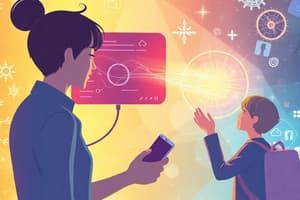Podcast
Questions and Answers
What defines media literacy?
What defines media literacy?
- The understanding of algorithms that personalize content.
- The capability to understand and assess different types of media and their messages. (correct)
- The skill to retrieve and understand information.
- The ability to use technology tools for various tasks.
Which of the following is a characteristic of misinformation?
Which of the following is a characteristic of misinformation?
- It is often spread with the intent to deceive. (correct)
- It is usually produced by reputable sources.
- It typically involves two-way communication.
- It can be easily validated by facts.
What role does media play as a watchdog?
What role does media play as a watchdog?
- It serves as a check on power holders such as governments. (correct)
- It personalizes content based on user preferences.
- It informs the public about entertainment options.
- It evaluates and manages technology tools effectively.
How does personalization of content occur on media platforms?
How does personalization of content occur on media platforms?
Which statement best describes technology literacy?
Which statement best describes technology literacy?
What is a primary function of the media in society?
What is a primary function of the media in society?
What is the main difference between media literacy and information literacy?
What is the main difference between media literacy and information literacy?
How can media amplify voices for social change?
How can media amplify voices for social change?
What role does the sender play in the communication process?
What role does the sender play in the communication process?
Which of the following is considered part of non-verbal communication?
Which of the following is considered part of non-verbal communication?
Which element helps the sender understand if their message was interpreted correctly?
Which element helps the sender understand if their message was interpreted correctly?
In what way does media influence the globalization of information?
In what way does media influence the globalization of information?
Which type of communication uses printed signs and symbols to convey messages?
Which type of communication uses printed signs and symbols to convey messages?
What does the term 'noise' refer to in communication?
What does the term 'noise' refer to in communication?
Which sub-type of non-verbal communication involves the use of personal space?
Which sub-type of non-verbal communication involves the use of personal space?
How does framing affect the presentation of information?
How does framing affect the presentation of information?
Flashcards are hidden until you start studying
Study Notes
Communication
- Defined as a two-way process of sharing ideas, thoughts, feelings, and emotions that leads to understanding.
Elements of Communication
- Sender: The initiator who encodes and sends the message.
- Receiver: The audience who decodes and interprets the message.
- Message: The actual information communicated, which can be verbal, non-verbal, or written.
- Channel: The medium used for message transmission (e.g., spoken words, text, email, social media).
- Noise: Interference that distorts or blocks message clarity (can be physical, psychological, or semantic).
- Feedback: The receiver's response, indicating whether the message was understood correctly.
Types of Communication
- Verbal Communication: Uses words to convey messages.
- Oral Communication: Involves spoken words and sounds.
- Written Communication: Involves printed signs and symbols.
- Non-Verbal Communication: Conveys messages without words.
- Kinesics: Body language.
- Haptics: Touch communication.
- Proxemics: Use of space in communication.
- Chronemics: Time-related cues in communication.
- Olfactics: Smell in communication.
- Artefactual: Communication through objects.
- Physical Appearance: Presentation of oneself.
Media and Information Influence on Communication
- Speed and Reach: Facilitates quick, global messaging in real-time.
- Globalization of Information: Enhances access and sharing of ideas across cultures.
- Diversity of Information: Provides varied sources and perspectives.
- Framing: Influences how information is presented, shaping audience perceptions.
- Social and Cultural Impact: Affects norms, values, and public opinion, reflecting societal changes.
- Interactive Communication: Allows two-way engagement through comments and shares.
- Misinformation and Disinformation: Can spread false data due to media's vast reach.
- Political and Social Movements: Media organizes and promotes activism and social change.
- Personalized Content: Algorithms tailor content to individual users' preferences.
Media and Information Literacy
- Developed by UNESCO in 2007 and considered a basic human right in the digital age.
- Involves skills to critically access, retrieve, evaluate, and use information from various media and technologies.
Media
- Refers to physical objects used in communication, including films, television, radio, and the internet.
Media Literacy
- Ability to identify different media types and their associated messages, enabling effective handling of information.
Information
- Encompasses facts learned about people, places, or things and aids in decision-making, empowering knowledge.
Information Literacy
- Defined as recognizing the need for information and effectively using it to address issues or problems.
Technology Literacy
- Ability to responsibly and effectively use technology tools for accessing, managing, integrating, evaluating, creating, and communicating information.
Roles of Media in Society
- Watchdog: Acts as a check on power holders like governments and corporations.
- Entertainment: Provides engaging content for leisure.
- Information and Education: Primary function is to inform and educate the public.
Studying That Suits You
Use AI to generate personalized quizzes and flashcards to suit your learning preferences.


